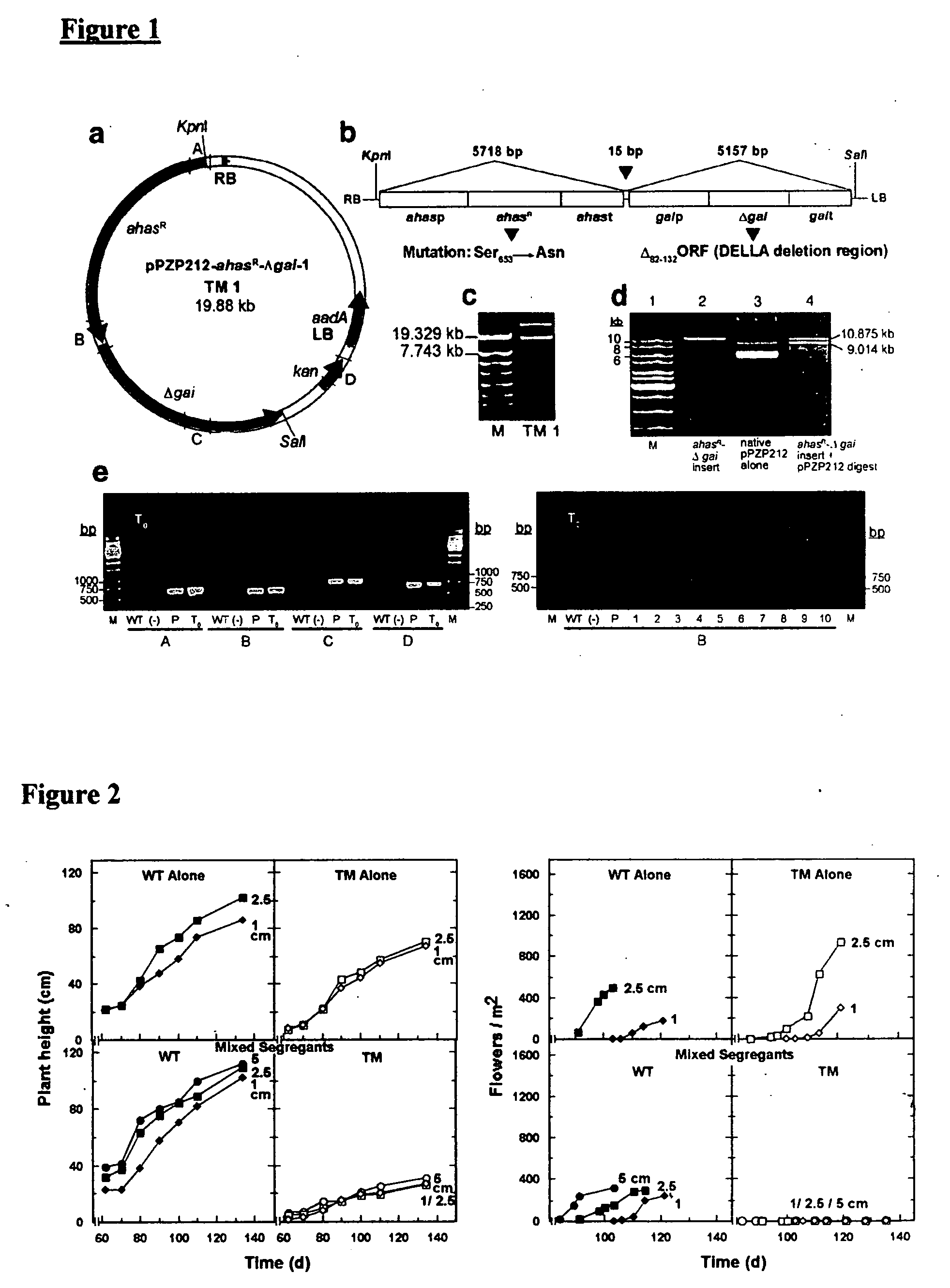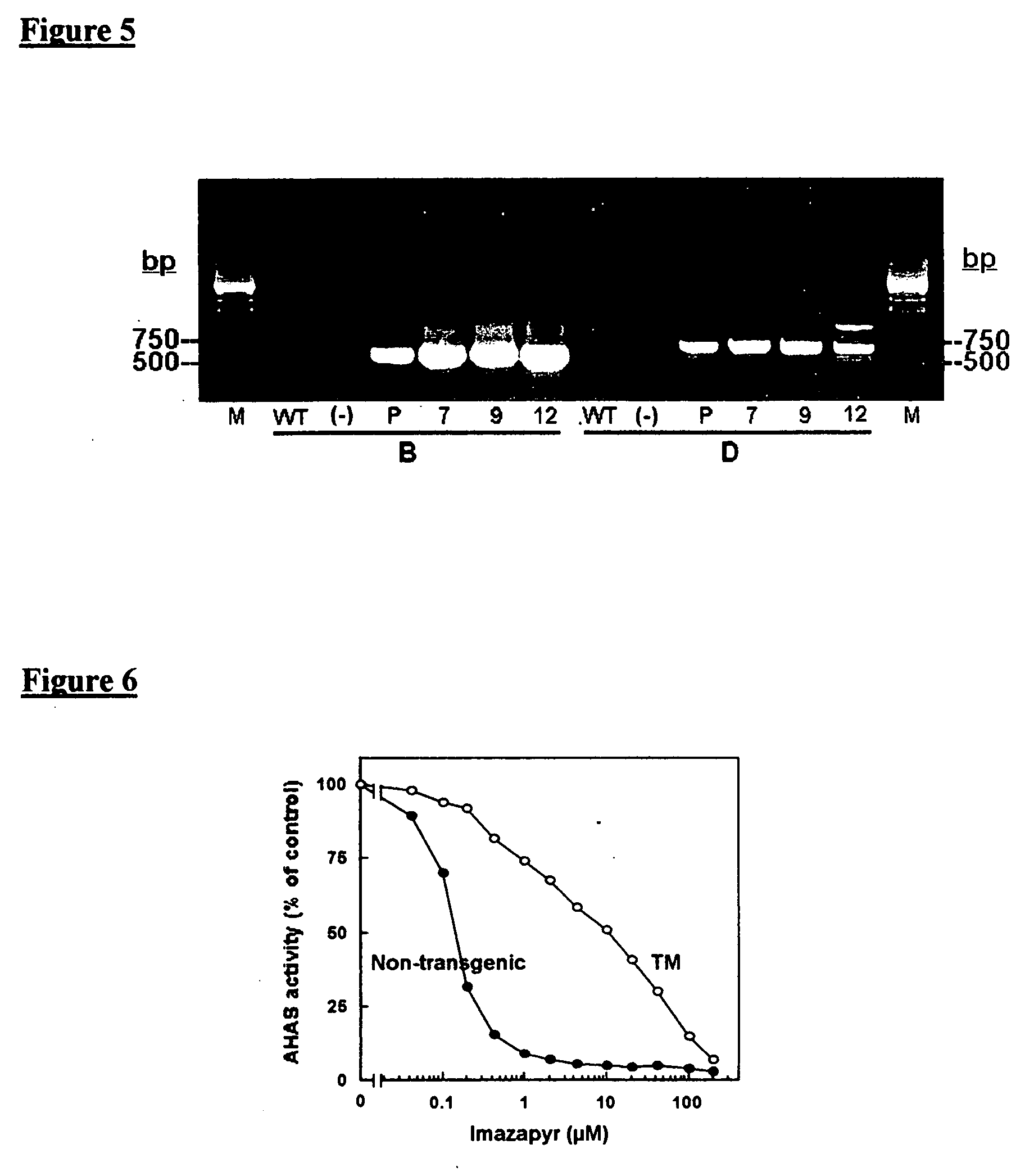Transgenic plants for mitigating introgression of genetically engineered genetic traits
a technology of genetic engineering and transgenic plants, applied in the field of transgenic plants, can solve the problems of unfavorable agronomic practice, unfavorable agronomic practice, and inevitable flow (leakage)
- Summary
- Abstract
- Description
- Claims
- Application Information
AI Technical Summary
Problems solved by technology
Method used
Image
Examples
example 1
Transgenic Litigation of Introgression of Herbicide Resistance by the Dwarfing .DELTA.gai Gene in Tobacco
[0140] One of the traits suitable for Transgenic Mitigation in constructs with a primary, desirable trait is dwarfing, which is caused by the well characterized .DELTA.gai gene (such as GenBank Accession No. AY142002, from Arabidopsis). While dwarfing is desirable in many crops, preventing lodging and producing less straw with greater yield, dwarfing would be disadvantageous to the rare weeds introgressing the TM construct, as these hybrids could no longer compete with other crops or with fellow weeds. In order to determine whether co-transformation of a desirable transgene with a mitigator gene would prevent proliferation of hybrids having the primary trait in the case of breach of containment, a tandem construct was made containing an ahas.sup.R (acetohydroxy acid synthase) gene (GenBank Accession No. X51514) for herbicide resistance as the primary desirable gene, and the dwarf...
example 2
Mitigation of Transgene Introgression in Oilseed Rape (B. napus) by Tandem Constructs using the Dwarfing .DELTA.gai Gene
[0163] A large variety of different primary genes have been inserted into oilseed rape, the crop source of canola oil (Table 2). Oilseed rape (Brassica napus) is an open-pollinated crop that crosses freely with a weedy relative (B. rapa) with which it shares one of its two similar genomes, and less freely with various other related species. The open pollinated nature of the species has already led to inadvertent stacking of herbicide resistance transgenes (Hall et al, Weed Sci 2000;48:688-94), and movement of transgenes into non-transgenic varieties. The herbicide resistance traits, in the related weedy species and in the volunteer weeds, could lead to control problems in rotational crops, especially when stacked, even further limiting the control options. The volunteer weed problems are exacerbated by the fact of oilseed rape not being fully domesticated. Many var...
example 3
Mitigation of Introgression of Genetically Engineered Pharmaceutical (and other) Transgenes in Corn--Precluding Volunteer Weed Problems and Gene Outflow
[0186] A large number of genes have been engineered into corn (Table 5), and corn with herbicide resistance genes and Bt insect resistance are in widespread agronomic use. For example, the US Environmental Protection Agency has recently (November 2003) approved the sale and use of YieldGard Plus corn by Monsanto, Inc, a variety of corn having genetically engineered resistance to corn borer and rootworm. Most of the genes engineered into corn pose no rational biosafety risk outside of the center of origin of corn, except were it is considered undesirable to have gene flow to organically cultivated crops. Nonetheless, a strong and very vocal opposition to the cultivation and use of genetically engineered corn has grown, exemplified by the costly and damaging recall of many corn products containing Aventis CropScience's "Starlink" Bt co...
PUM
| Property | Measurement | Unit |
|---|---|---|
| Electrical resistance | aaaaa | aaaaa |
| Cytotoxicity | aaaaa | aaaaa |
Abstract
Description
Claims
Application Information
 Login to View More
Login to View More - R&D
- Intellectual Property
- Life Sciences
- Materials
- Tech Scout
- Unparalleled Data Quality
- Higher Quality Content
- 60% Fewer Hallucinations
Browse by: Latest US Patents, China's latest patents, Technical Efficacy Thesaurus, Application Domain, Technology Topic, Popular Technical Reports.
© 2025 PatSnap. All rights reserved.Legal|Privacy policy|Modern Slavery Act Transparency Statement|Sitemap|About US| Contact US: help@patsnap.com



